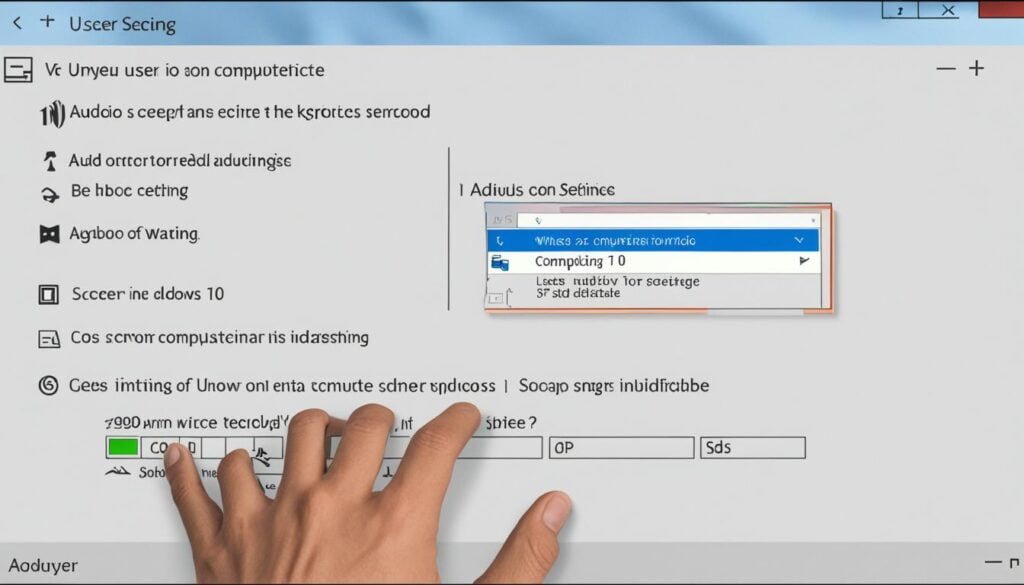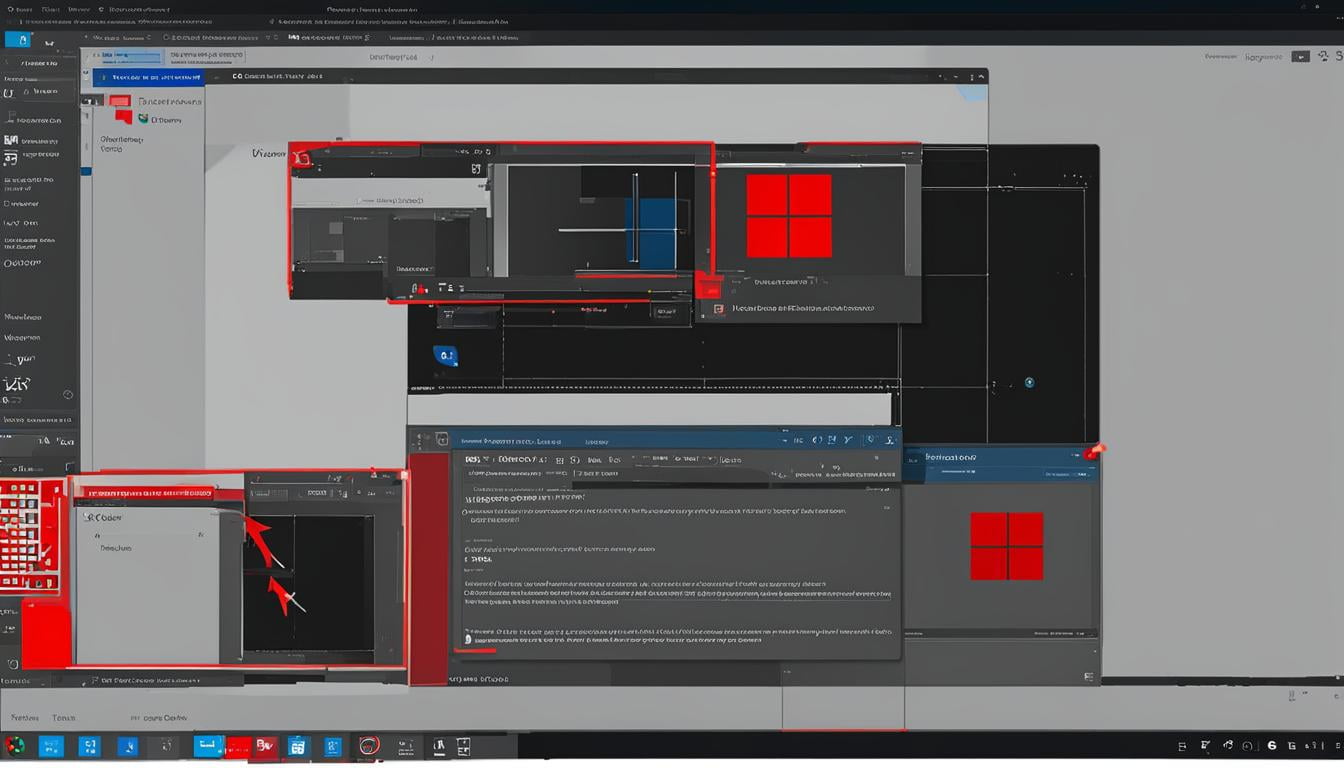Contents
- 1 Check Physical Connections
- 2 Troubleshoot App Settings
- 3 Update Audio Drivers
- 4 Adjust Audio Settings
- 5 Test the Microphone
- 6 Check App Permissions
- 7 Restart the Computer
- 8 Disable Xbox Game Bar and Captures
- 9 Adjust Microphone Settings in Apps
- 10 Conclusion
- 11 FAQ
- 11.1 How can I fix microphone issues on Windows 10?
- 11.2 What should I do if my microphone is not detected on Windows 10?
- 11.3 How can I troubleshoot microphone issues in applications on Windows 10?
- 11.4 How can I update audio drivers on Windows 10 to fix microphone issues?
- 11.5 How do I adjust audio settings on Windows 10?
- 11.6 How can I test the microphone on Windows 10?
- 11.7 How can I check app permissions for the microphone on Windows 10?
- 11.8 Should I restart my computer to fix microphone issues on Windows 10?
- 11.9 How do I disable Xbox Game Bar and Captures to fix microphone issues?
- 11.10 How can I adjust microphone settings in specific apps on Windows 10?
If you are experiencing microphone problems on your Windows 10 device, there are several easy resolution tips you can try. By following these steps, you can troubleshoot and resolve common microphone issues, such as a microphone not working, not being detected, or not picking up sound.
Key Takeaways:
- Tips to resolve microphone not working on Windows 10
- Easy resolution tips for fixing microphone issues
Check Physical Connections
When troubleshooting microphone issues on Windows 10, one of the first steps you should take is to check the physical connections of your microphone. By ensuring a proper physical connection, you can eliminate any potential hardware issues that may be causing the problem.
To begin, unplug the microphone from your computer and then plug it back in. This simple action may reestablish the connection and resolve the problem. If Windows detects the new hardware with a sound prompt, it indicates that the connection is fine.
If, however, the microphone is still not detected after reinserting it, try connecting it to a different USB port or using a different cable. Sometimes, faulty USB ports or cables can prevent the microphone from being recognized by the system. Testing the microphone on another computer can also help determine if it is functional.
Physical Connection Checklist:
- Unplug and plug the microphone back in
- Try connecting the microphone to a different USB port
- Use a different cable to connect the microphone
- Test the microphone on another computer
If the physical connection is the root cause of the microphone issue, these troubleshooting steps should help you resolve the problem. However, if the problem persists, there may be other factors at play, which we will explore in the following sections.
Troubleshoot App Settings
If your microphone is only experiencing problems in a specific application, it’s important to check the app settings. Follow these steps to troubleshoot microphone issues in applications on Windows 10:
- Open the sound settings in Windows by right-clicking on the speaker icon in the taskbar and selecting “Open Sound settings”.
- Select the “Input” tab and locate your microphone from the list of input devices.
- Start a test to see if Windows detects the input from your microphone. This can be done by tapping on the microphone or speaking into it.
- If the test is successful and Windows detects the input, the issue may be with the settings in the app itself.
- Open the app where you’re experiencing microphone problems.
- Look for audio device options or settings within the app and make sure the correct microphone is selected.
- Restart the app and test the microphone again to see if the issue is resolved.
By following these troubleshooting steps, you can identify and resolve microphone issues specific to applications on Windows 10.
Update Audio Drivers
Outdated or faulty audio drivers can cause microphone issues on Windows 10. To resolve these problems, it’s important to update your audio drivers regularly. Here’s how:
1. Check the Device Manager by pressing the Windows key + X and selecting Device Manager from the menu.
2. In the Device Manager window, expand the “Audio inputs and outputs” section.
3. Locate your microphone in the list. If it is listed, right-click on it and select “Update Driver.”
4. Windows will search for updated drivers automatically. If an update is found, follow the prompts to install it.
5. If no driver update is available through Windows, visit the manufacturer’s website for your microphone to download and install the latest driver manually.
Updating your audio drivers can often resolve microphone issues on Windows 10 by ensuring that your device is equipped with the latest software and drivers. Keep in mind that different microphones may have different driver installation processes, so it’s always a good idea to consult the manufacturer’s documentation for specific instructions.
Adjust Audio Settings
When troubleshooting microphone issues on Windows 10, it’s essential to adjust the audio settings to ensure proper configuration for your microphone. Follow these steps to adjust the audio settings:
- Open the Sound settings in Windows 10.
- Go to the Recording tab.
- If your microphone is disabled, enable it by right-clicking on the microphone option and selecting “Enable”.
- If your microphone is not set as the default device, right-click on the microphone option and select “Set as Default Device”.
- Check the volume levels of your microphone and adjust them accordingly. Ensure that the volume is not too low or too high.
- If you have hands-free Bluetooth devices connected to your computer, disable them temporarily as they may interfere with the microphone’s functionality.
By adjusting the audio settings in Windows 10, you can optimize the performance of your microphone and resolve any related issues.

| Common Audio Settings | Description |
|---|---|
| Microphone Enable/Disable | Enables or disables the microphone for use. |
| Default Device | Set the microphone as the default device for recording audio. |
| Volume Levels | Adjust the microphone’s volume levels to ensure optimal sound quality. |
| Bluetooth Devices | Temporarily disable hands-free Bluetooth devices when troubleshooting microphone issues to eliminate interference. |
Test the Microphone
After making the necessary adjustments, it is essential to test the microphone to ensure it is working properly. There are a couple of ways to test your microphone on Windows 10.
One option is to use the built-in microphone test feature in the Sound settings. Simply open the Sound settings, navigate to the Recording tab, select your microphone, and click on the “Test” button. This will allow you to check if the microphone is picking up sound correctly.
Another option is to use a third-party app like Voice Recorder or Audacity. These apps provide more advanced recording features and can help you assess the quality of your microphone. Record your voice using one of these apps and play it back to check for any issues such as low volume or distortion.
If, despite these tests, your microphone is still not picking up sound, it may be necessary to troubleshoot further. Proceed to the next step to continue resolving the issue.
Check App Permissions
When troubleshooting microphone issues on Windows 10, it is essential to check the app permissions for accessing the microphone. Failure to grant proper permissions can lead to microphone not working after Windows 10 update. To resolve this problem, follow the steps below:
- Open the Privacy settings in Windows 10.
- Navigate to the Microphone privacy settings.
- Ensure that the “Allow apps to access your microphone” option is enabled.
- Check the individual app permissions and make sure that the microphone is granted access to the specific app.
If you find that the microphone permission was disabled or not granted to a particular app, enable it to fix microphone issues. However, if the problem persists, it’s advisable to move on to the next troubleshooting step.

In some cases, the microphone not working after Windows 10 update can be attributed to app permissions. It is crucial to double-check these settings to ensure the microphone is allowed access to the necessary applications.
Restart the Computer
Sometimes a simple restart can resolve microphone issues. Restarting your computer can help fix temporary software or system glitches that might be causing the problems with your microphone. To restart your computer, follow these steps:
- Save any unsaved work and close all open programs.
- Click on the Start button in the bottom left corner of your screen.
- Select Power and then choose Restart.
- Wait for your computer to shut down and start up again.
Once your computer has restarted, test your microphone again to see if the issue has been resolved.

Remember, if the microphone problem persists, don’t worry. There are still additional troubleshooting steps you can try to fix the issue. The next section will guide you through disabling Xbox Game Bar and Captures, which can sometimes interfere with microphone functionality in specific games.
Disable Xbox Game Bar and Captures
If you’re facing microphone issues specifically while gaming on Windows 10, the Xbox Game Bar and Captures features may be the culprit. These features can interfere with the microphone functionality, leading to a non-working microphone in games. To resolve this problem, follow the steps below:
- Open the Gaming settings in Windows 10.
- Locate and disable the Xbox Game Bar option.
- Turn off the screen capture options as well.
By disabling the Xbox Game Bar and Captures, you can eliminate any potential conflicts between these features and your microphone, allowing your microphone to function properly during gaming sessions.

Additional Tip:
If you’re still experiencing microphone problems after disabling the Xbox Game Bar and Captures, try closing any unnecessary background applications to free up system resources for better microphone performance.
| Problem | Solution |
|---|---|
| Microphone not working in games | Disable Xbox Game Bar and Captures |
Adjust Microphone Settings in Apps
If you are encountering issues with your microphone not working properly in a specific app, don’t worry. There are steps you can take to adjust the microphone settings and resolve the problem.
Start by accessing the settings within the app where you’re experiencing the microphone issue. Look for the microphone options and ensure that the app is using the correct microphone input. Some apps may have multiple options for microphone input, so it’s important to choose the right one.
You’ll want to confirm that the right microphone is selected and adjust any additional settings within the app that relate to microphone functionality. Make sure to save the changes and exit the settings menu.
It’s also crucial to check if any other apps are simultaneously using the microphone. Multiple apps attempting to access the microphone at the same time can lead to conflicts and result in your microphone not working as expected. Close any other apps that might be using the microphone, and then relaunch the app where you were experiencing the issue.
By adjusting the microphone settings in the specific app and ensuring exclusive access to the microphone, you can address the problem and use your microphone effectively.
Example: Microphone Settings in the XYZ App
| Step | Description |
|---|---|
| 1 | Open the XYZ app on your Windows 10 device. |
| 2 | Go to the app’s settings menu by clicking on the gear icon. |
| 3 | Look for the “Audio” or “Microphone” section. |
| 4 | Verify that the correct microphone input is selected. If necessary, choose the appropriate microphone from the available options. |
| 5 | Adjust any additional microphone settings, such as volume or sensitivity. |
| 6 | Save the changes and exit the settings menu. |
| 7 | Close any other apps that might be using the microphone simultaneously. |
| 8 | Relaunch the XYZ app and test your microphone to ensure it is now working as intended. |
By following these steps, you can adjust the microphone settings in the app and resolve any issues with your microphone not working correctly.
Conclusion
Troubleshooting microphone issues on Windows 10 can be a relatively straightforward process. By following the recommended tips, you can easily resolve common microphone problems and get your audio back on track.
To begin, make sure to check the physical connections of your microphone. Unplug it and then plug it back in to ensure a secure connection. If the microphone is still not detected, try using a different USB port or cable. Testing the microphone on another computer can also help determine if the issue lies with the device itself.
Next, troubleshoot the app settings. Open the sound settings in Windows and select the microphone to perform a test. If Windows detects the input, the issue may be with the settings in the specific application. Look for audio device options or settings within the app and ensure the correct microphone is selected.
Updating audio drivers, adjusting audio settings, and testing the microphone are also crucial steps in resolving microphone issues. Additionally, checking app permissions, restarting the computer, and disabling Xbox Game Bar can further aid in troubleshooting. Adjusting microphone settings within apps and consulting the manufacturer’s documentation or support can provide further guidance.
FAQ
How can I fix microphone issues on Windows 10?
There are several easy resolution tips you can try to fix microphone issues on Windows 10. These include checking physical connections, troubleshooting app settings, updating audio drivers, adjusting audio settings, testing the microphone, checking app permissions, restarting the computer, disabling Xbox Game Bar, and adjusting microphone settings in apps.
What should I do if my microphone is not detected on Windows 10?
If your microphone is not being detected on Windows 10, try checking the physical connections by unplugging and plugging it back in. If that doesn’t work, try connecting it to a different USB port or using a different cable. You can also test the microphone on another computer to see if it is functional.
How can I troubleshoot microphone issues in applications on Windows 10?
If your microphone is only experiencing problems in a specific application, you can troubleshoot app settings. Open the sound settings in Windows, select the microphone, and start a test to see if Windows detects the input. If the test is successful, the issue may be with the settings in the app itself. Look for audio device options or settings in the app and make sure the correct microphone is selected.
How can I update audio drivers on Windows 10 to fix microphone issues?
To update audio drivers on Windows 10, open the Device Manager and check the Audio inputs and outputs section. If the microphone is listed, right-click it and select Update Driver. Windows will search for updated drivers automatically. If no driver is found, visit the manufacturer’s website to download and install the latest driver for your microphone.
How do I adjust audio settings on Windows 10?
To adjust audio settings on Windows 10, open the Sound settings and go to the Recording tab. Enable the microphone if it is disabled and set it as the default device if it is not already. Check the microphone’s volume levels and adjust them accordingly. Disable any hands-free Bluetooth devices that may be interfering with the microphone.
How can I test the microphone on Windows 10?
You can test the microphone on Windows 10 by using the built-in microphone test option in the Sound settings. You can also use third-party apps like Voice Recorder or Audacity to record your voice and check for any issues, such as low volume or distortion.
How can I check app permissions for the microphone on Windows 10?
To check app permissions for the microphone on Windows 10, go to the Microphone privacy settings and ensure that the “Allow apps to access your microphone” option is turned on. Additionally, check the individual app permissions to ensure that the microphone is allowed to access the specific app.
Should I restart my computer to fix microphone issues on Windows 10?
Yes, sometimes a simple restart can resolve microphone issues on Windows 10. Restart your computer and test the microphone again after the reboot. In some cases, the issue may be due to temporary software or system glitches that are resolved with a restart.
How do I disable Xbox Game Bar and Captures to fix microphone issues?
To disable Xbox Game Bar and Captures, go to the Gaming settings in Windows 10 and turn off the Xbox Game Bar and screen capture options. This can help resolve microphone issues that occur specifically in gaming applications.
How can I adjust microphone settings in specific apps on Windows 10?
To adjust microphone settings in specific apps on Windows 10, check the app’s settings for microphone options. Confirm that the app is using the correct microphone input and adjust the settings accordingly. Make sure that no other apps are accessing the microphone at the same time, as this can cause conflicts.
